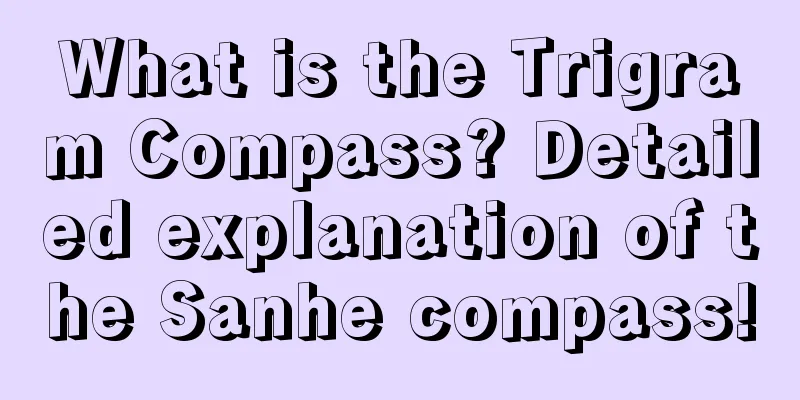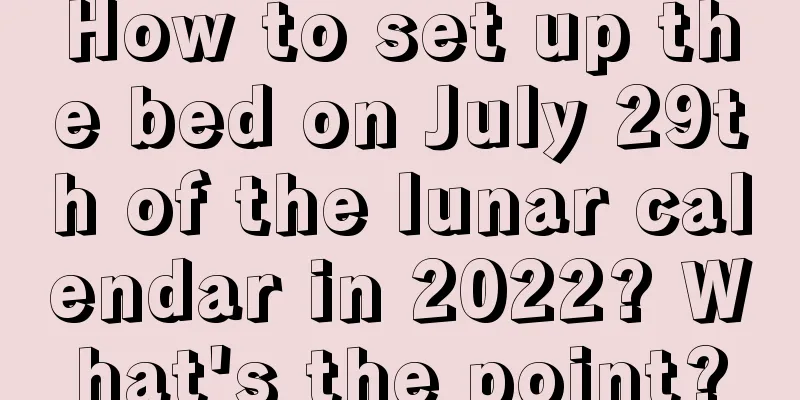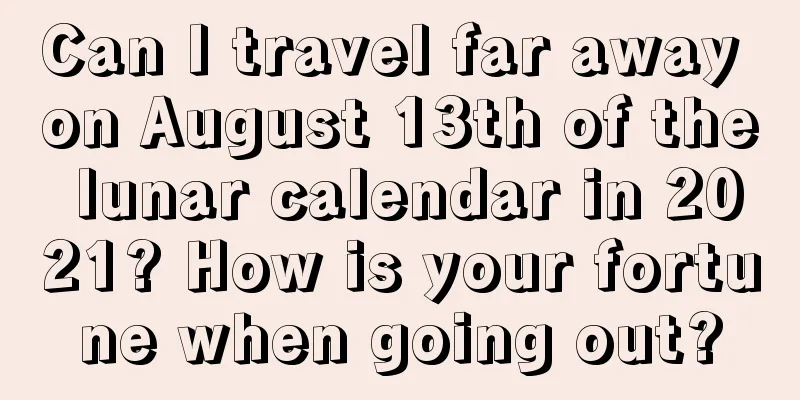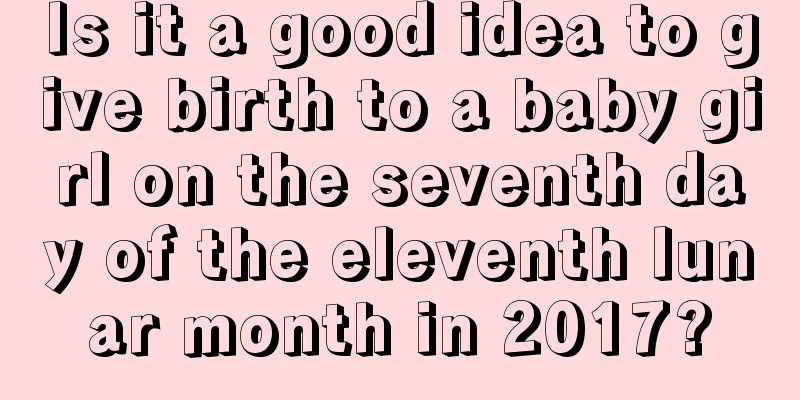What is the Trigram Compass? Detailed explanation of the Sanhe compass!

|
Introduction: Compass, also known as compass, has had different numbers of layers throughout history. Some have as many as thirty-six floors. The orthodox Sanhe Plate that is now popular among the people. So what is the Sanhe compass? What is the use of the Sanhe compass? Let’s follow the editor to learn more about it! Want to know more articles and content related to the compass? Welcome to the compass special topic that Mr. Shui Mo has carefully prepared for you to learn more knowledge. Come and have a look! Sanhe compass Generally speaking, the functions of a compass can be divided into two categories. One is direction finding, which is the compass used in ancient navigation; the other is divination by magic, which is the main function of the compass used in ancient geomancy. Of course, it can also find direction, but it has many more contents than a nautical compass, and these contents are mainly used for direction finding. What is introduced here is the geomancy compass or feng shui compass. Compass has many aliases, such as compass, compass plate, compass needle, compass needle, compass plate, etc., which mean to cover all directions and the longitude and latitude of heaven and earth. It consists of a magnetic needle for indicating direction and a divination plate for measuring direction. The compass is located in the center of the compass, and it is surrounded by the divination plate, which is a direction plate composed of several layers of numerology characters arranged in concentric circles according to certain rules and principles. In addition, the compass is divided into two parts: the celestial plate and the earthly plate, symbolizing that the sky is round and the earth is square. The celestial plate is the inner plate, which is composed of a magnetic needle and a circular divination plate. The various contents of the compass are engraved on different circles on the surface of the inner plate. The inner plate can rotate and is the main body of the compass. The earth plate is the outer plate, which is square. Outside the inner plate, it is the tray of the inner plate. There are no words on the surface of the plate, only the M-shaped line indicating the direction. Many compasses are not necessarily equipped with a earth plate. The compass is a major invention of ancient Chinese science and technology. Its use itself has a process, and this process also reflects the evolution of the compass. It has evolved from simple to complex, and has formed a variety of styles. However, due to the differences in Feng Shui schools and master inheritance, different types of Feng Shui have been formed. The same type of compass also has slight differences due to different Feng Shui masters' inheritance and different places of origin. In addition, the same type of compass will contain more or less circle contents due to different sizes. In terms of types, the ones that have been passed down since the Ming and Qing Dynasties are roughly divided into three types: Sanhe plate, Sanyuan plate and comprehensive plate. The Sanhe Plate is most popular in Huizhou. : : : : : : : : : : : : : : : Regardless of the type of compass, there are only a few features: first, it uses a compass for orientation; second, it has a rotatable circular engraved plate; third, it is mainly used to determine the direction of good or bad luck. Due to the different users and objects used, compasses come in different sizes, with the largest being about a foot in diameter and the smallest being able to be placed in the palm of your hand; the number of layers also varies, with as few as three or five and as many as thirty or forty. Generally speaking, small compasses have a small diameter, fewer circles, and slightly lower accuracy, but they are easy to carry. Large compass circles have more content, a large amount of information, and high accuracy, but they are large in size and inconvenient to carry. A medium-sized compass is somewhere in between and is sufficient in most situations. Below, we will take the 5.5-inch three-in-one, sixteen-layer Huizhou plate produced by Wu Luheng, the most popular in Huizhou, as an example to introduce its contents layer by layer. First layer: The center layer of the Tianchi compass is always where the compass is located. This is a custom and there are no exceptions. This layer of the compass is called "Tianchi", which should come from the fact that the early compass magnetic needle was in the form of a water-filled floating needle. Because the needle needed to be filled with water, it was named "chi". It also has another name called Tai Chi. "The Book of Changes: Xici" says: "The Book of Changes has Tai Chi." In the ancient cosmology, Tai Chi is one of the most primitive states in the evolution of heaven and earth. It is the so-called world without distinction between yin and yang and without image or form. In the Book of Changes, Xici, it is also said: "This gives rise to the two opposites." Yin and Yang are divided by two principles, that is, Tai Chi gives birth to Yin and Yang. The compass specifies north and south at the Tai Chi level, and also distinguishes yin and yang. The character for Yin and Yang in ancient Chinese characters is “月易”. "Shuowen Tongxun Dingsheng" says: "Yue means seeing the clouds but not the sun, and Yi means the clouds open and the sun appears." This refers to the situation of being affected by Yang. The ancients measured the sun's shadow to obtain cold and warm, Yin and Yang, and chose to live in the south of the mountain, which is called the Yang direction, and the north of the mountain, which is called the Yin direction. This is the original meaning of Yin and Yang in the north and south directions of the compass. Tai Chi gives birth to Yin and Yang, which not only refers to the north and south, but also refers to the two opposite and unified attributes of things. In Feng Shui, it evolves into the pair of attributes of growth and decline, mutual generation and mutual restraint. This cleverly combines the direction-finding function of the compass with the orientation function of the compass by replacing the concepts. The yin and yang of divination are determined from this level, and establish relationships with the eight trigrams, yin and yang, directions, etc. that are derived from this level. The south end is painted red because according to the theory of Yin and Yang and the Five Elements, the south represents fire and the Vermillion Bird, so it is painted red. There is a black line at the bottom of Tianchi Lake, called the seabed line. When using a magnetic needle, the north-south direction must coincide with the bottom line. In this way, after the compass specifies the north and south, the meridian is determined, and the yin and yang begin to differentiate from the floating needle layer. Second layer: The Eight Evils on the Dragon Some of the Eight Evils on the Dragon are called the Eight Yao Evils, the Eight Evils Sitting on the Mountain, etc. It is in the form of eight squares around the circumference, with a branch marked on each square. It is based on the relationship between King Wen's Eight Trigrams (i.e. the Later Heaven Eight Trigrams) and the eight branches of the twenty-four directions, so the Later Heaven Eight Trigrams are rarely directly included in the Hui plate. This involves the coordination of the Eight Trigrams, Earthly Branches, and the Five Elements. There are six lines in a hexagram. According to the principle of pregnancy and development of the Na Jia theory, the six lines are matched with the six branches respectively. If the first line of Qian hexagram intersects with Kun to obtain Zhen, it means that the parents will give birth to a son, so the first line of Zhen hexagram matches the earthly branch Zi. Count the six branches starting with Zi. Because Zhen is Yang and odd, we should count the six odd-numbered branches starting with Zi. In this way, the six lines of Zhen are matched with the six branches: the first nine is matched with Zi, the second six is matched with Yin, the third six is matched with Chen, the fourth nine is matched with Wu, the fifth nine is matched with Shen, and the sixth six is matched with Xu. Zhen belongs to the element of wood, and among the six branches only Shen belongs to metal. Metal can overcome wood, so Shen overcomes Zhen. Among the twenty-four directions, the four cardinal directions use branches instead of hexagrams. Zhen is due east, which is the position of Mao, and Mao also belongs to wood. Therefore, the Mao direction and the Shen direction establish a corresponding restraining relationship. In this layer of the compass, the square adjacent to Zhen is marked with the word Shen. The first line of Qian intersects with Kun to form Gen. The ninth line of Qian includes the first odd-numbered branch after Yin, which is Chen. The sixth line of Gen also includes the first odd-numbered branch after Chen. Qian, Zhen, Kan and Gen are the four Yang hexagrams. They all include the odd-numbered Earthly Branches in sequence, so that we get the six Earthly Branches that match each of the four Yang Hexagrams. Then, according to the Five Elements of the Eight Trigrams and the Five Elements of the Earthly Branches, we can get the Earthly Branch that each hexagram counteracts. Similarly, the four Yin hexagrams are obtained by reversing the digits. The result of this deduction is: the eight groups of branches and hexagrams have a restraining relationship, namely, Qianwu, Kunmao, Zhenshen, Xunyou, Kanchen, Lihai, Genyin and Duisi. The "Xuannv Jing" says: "The compass uses the ghost lines to count backwards." Nazhi is the order in which the Yin and Yang lines of Qian and Kun intersect one line at a time, from the first line of the hexagram to the upper lines, which is also the reverse order. "Yunlu Manchao" has a diagram of Na Jia, in which the eight trigrams are listed in one layer and coordinated with the five elements, which clearly explains the principle of the eight evil spirits of the compass. The rule is: "Ganshan Renwu is not suitable, Yimao Kunshan must be guarded against." The relationship between Qian and Wu, Kun and Mao has been mentioned above. The relationship between Qian and Ren, Kun and Yi is also established according to the principle of Bagua fetal development. Qian is the father and Kun is the mother, and the two are the upper and lower ends of the Heavenly Stems. Qian includes Jia and Ren, Kun includes Yi and Gui, and the remaining six hexagrams are born from Qian and Kun. They respectively include the remaining six Qians, namely Zhen, Geng, Xun, Xin, Kan, Wu, Li, Si, Gen, Bing, and Dui, Ding. The Heavenly Stems contained in the Eight Trigrams are combined with the six Branches contained in them to form the Six Jias. Because Qian and Kun each contain two Gan, the first three pairs of the six Jia they match use Jia and Yi, and the last three pairs use Ren and Gui. Since Gan and Wu are in conflict with each other, the Jiazi and Renwu in which Wu is located are also in conflict with Gan. In other words, the mutual restraint between the Earthly Branches is expanded to the mutual restraint between the Stems and Branches, and the resulting mutual restraint relationship is still established between the Eight Branches and the Eight Trigrams. In this way, we can obtain the mutual restraining relationship between the Eight Trigrams and the eight pairs of Stems and Branches, namely, Gan and Renwu, Kun and Yimao, Zhen and Gengshen, Xun and Xinyou, Kan and Wuchen, Li and Yihai, Gen and Bingyin, and Dui and Dingsi. The compass uses this layer to determine the good or bad luck of the sitting point and orientation, and to explain the relationship between dragon and water. The dragon mentioned in geomancy refers to the direction, changes and momentum of the mountain range, the so-called "coming dragon". If the dragon vein is active, the burial site should be located where the dragon vein forms a cave. However, the dragon must also complement the incoming water. If the dragon vein and the water mouth are not in harmony, it is called "Sha", which means danger and ruin. If you encounter evil, you must avoid it, otherwise it will become a dangerous place. (The same applies to yang houses) For example, "Kan dragon should not be located in the Chen direction", that is, the position of Zi among the twenty-four directions should avoid conflict with the Chen direction (for example, it is not appropriate to open the door in the Chen direction, and there should be no obstacles in the Chen direction, etc.). According to King Wen's Eight Trigrams, Kan is the Zi position. Among the Eight Killings, Chen is earth that overcomes water, and Chen is the location of the southeast direction. Others include: "Kun dragon cannot be located in the Mao direction, Mao dragon cannot be located in the Shen direction, Xun dragon cannot be located in the You direction, Gan dragon cannot be located in the Wu direction, You dragon cannot be located in the Si direction, Gen dragon cannot be located in the Yin direction, and Wu dragon cannot be located in the Hai direction". Besides, there is a poem about this saying: "Kan dragon, Kun rabbit, Zhen mountain monkey, Xun chicken, Gan horse, Dui snake head, Gen tiger and Li pig are evil stars, if you encounter one of them, it will be bad luck in your tomb or house." The zodiac signs are used here to represent the earthly branches, and its essence is also the theory of the Eight Killings of the branches overcoming the hexagrams. Third layer: The Eight Evils Yellow Springs is also known as the Eight-Road Yellow Springs. It is also in the form of twenty-four grids, that is, each grid of the Eight Trigrams is further divided into three grids, twelve of which are marked with words. Among the twenty-four directions, the four straight directions are Zi, Wu, Mao and You, and the four branches on the left and right are the heavenly stems; the four corners are Qian, Kun, Gen and Xun hexagrams, which belong to the post-natal eight trigrams; the four hexagrams are the earthly branches respectively. The divination method of Huangquansha is to talk about the relationship between the four hexagrams and the two adjacent days and one stem. The rules are: "Geng and Ding are in Kun, which is the Yellow Spring; Yi and Bing must be careful of Xun water; Jia and Gui should not see Gen in the middle; Xin and Ren are afraid of the dry water route." Among them, Geng, Ding and Kun are adjacent, and every two stems and the hexagram they are sandwiched between are in a restraining relationship. The four corners are called the four tombs in the art of magic. Yang Yunsong said in "The Secret Meaning of the Green Bag": "Chen, Xu, Chou and Wei correspond to the constellations of Kang, Niu, Lou and Gui, so the ancients regarded the four tombs as the golden dragon." The four corners are located at Kang, Niu, Lou and Gui, so this layer is also called the tomb of the eight stems. This is a manifestation of the special status of the four corners in divination, which has the same meaning as the four gates of heaven, earth, man and ghost in the early days of divination. The four corners require certain directions to be coordinated. Not all directions can be coordinated with the four corners to be auspicious. The eight stems’ tombs and killings are the rules. There are eight things that are auspicious and inauspicious in the four corners, so they are called the Eight Evils There are Yellow Springs underground in these eight directions, which are the evil directions, so they are called the Eight Evil Yellow Springs. This is an extension of the meaning of the Eight Gan Tomb Killings. Of course, this is a common name, but common names are often also technical names. The form of this layer of the compass is that in the grids corresponding to the four hexagrams in the four corners, there are marked two stems that are not suitable, such as: Ding and Geng are marked in the Kun grid, Xin and Ren are marked in the Gan grid, Yi and Bing are marked in the Xun grid, and Jia and Gui are marked in the Gen grid; in the grids corresponding to the eight stems, there are marked the names of the hexagrams that are not suitable, such as: Ding and Geng are marked in the two grids, Yi and Bing are marked with Xun, Jia and Gui are marked with Gen, and Xin and Ren are marked with Gan. This layer consists of twenty-four grids, which are used in conjunction with the twenty-four directions. It is the part of the compass that uses the main needle to occupy the twenty-four directions. Fourth floor: The nine stars of the mountain are Tan, Ju, Lu, Wen, Lian, Wu, Po, Fu and Bi. It is the Big Dipper plus the two stars Fu and Bi. The names of the Big Dipper are, in order: "Van Lang, Ju Men, Lu Cun, Wen Qu, Lian Zhen, Wu Qu and Po Jun. They use Indian names. For example, Chen Zungui said in "History of Chinese Astronomy": "According to the translated Buddhist scriptures, India regards the Big Dipper as a symbol of a general." The reason why Indian names are used on the compass is probably because these names have more humanistic meanings. As for the two stars of Fu and Bi among the nine stars, according to "Song History·Astronomy", "The eighth is called Bi, to the right of the seventh star, invisible, and in the Han history it governs Youzhou. : : : : : : : : : : : : : : : Fifth floor: The layer of twenty-four mountains on the twenty-four-mountain compass is the most important content on its plate, and all compasses must have this layer. The twenty-four mountain directions are divided into twenty-four grids in a circle, with the twelve branches, four hexagrams and eight stems listed on top, and each grid occupies fifteen degrees. Its stems, branches and hexagrams are arranged as follows: the four branches are Zi, Wu, Mao and You in the four cardinal directions, and the four hexagrams are Qian, Kun, Gen and Xun in the four corners; Zi, Wu, Mao and You have two stems on each side, and the remaining eight squares are eight branches. The formation of this arrangement has to start with the principles of numerology. In "Huainanzi Tianwenxun", there are the five elements attributes of the five directions and the stems and branches. It is not difficult to deduce the directions of the stems and branches from these relationships. The east is associated with wood, so the two heavenly stems that are wood - Jia and Yi and the two earthly branches that are wood - Yin and Mao are both located in the east. By analogy, we can get: The southern heavenly stems are Bing and Ding, and the earthly branches are Si and Wu; the western heavenly stems are Geng and Xin, and the earthly branches are Shen and You; the northern heavenly stems are Ren and Gui, and the earthly branches are Hai and Zi. There is also a saying of "two ropes and four hooks" in "Astronomy Training". The two ropes are the longitude and latitude. The two ropes have four ends, which are the four Zhong. The four hooks are the four dimensions or four corners. "Astronomy Training" says: "Ziwu, Maoyou are two ropes, Chouyin, Chensi, Weishen, Xuhai are four hooks." In this way, the positions of the earthly branches in the four cardinal directions and four corners were regulated: Zi was located in the due north, Wu was in the due south, Mao was in the due east, and You was in the due west. According to the theory of the five elements of the earthly branches, Hai is located on the north side of Zi and is adjacent to Xu, forming one dimension. Chou is located on the other side of Zi, and it forms one dimension with the adjacent Yin. In other words, the northwest corner is formed by Hai in the north and Xu in the west, and the northeast corner is formed by Chou in the north and Yin in the east. Similarly, we can know the three earthly branches in each direction. If we arrange them in clockwise order, we can get the Earthly Branches and Heavenly Stems positions map in "Astronomy Training". After verification, it is found that the Han-style arrangement format of the heavenly stems and earthly branches is the same as that described in the Tianwen Xun. Wang Yinglin said in "Xiaoxue Canzhu": "Zichou is water, Yinmaochen is wood, Siwuwei is fire, Shenyouxu is metal, and Hai is water." According to the principle of matching the five elements with the five directions, the directions of the earthly branches are easy to understand. The twenty-four mountains of the main needle are divided into yin and yang, and the method of dividing yin and yang is different in the Sanhe plate and the Sanyuan plate. The yin and yang of the twenty-four mountains in the Sanyuan plate are determined based on the three-yuan dragons of heaven, earth and man, while the yin and yang of the twenty-four mountains in the Sanhe plate are determined based on the relationship between the innate Bagua and the Luoshu, as well as the theory of Na Jia and the three combinations of the four main hexagrams of the acquired Bagua. In some early Huipan and Jianpan, there is often a separate layer of "Twelve Dragons of Yin and Yang" within the layer of twenty-four mountain directions, marked with red circles and black dots to indicate the division of the twenty-four mountain directions into two parts of yin and yang. Of course, in most cases, red fonts are used to represent Yang dragons and black fonts are used to represent Yin dragons in the twenty-four mountains. This is an improved method of combining two layers into one. In fact, the Yin-Yang dragon pattern still exists. As mentioned before, the division of yin and yang comes from the numbers of Na Jia and Luo Shu. The numbers in the Luoshu "wear one and wear nine, three on the left and seven on the right, two and four are shoulders, six and eight are feet" match the directions of the Eight Trigrams. The southern Gan matches nine, the northern Kun matches one, the eastern Li matches three, and the western Kan matches seven. The four cardinal hexagrams are all odd numbers, odd means yang, so these four hexagrams are yang. Similarly, it can be seen that the four corner hexagrams of Gen, Zhen, Xun and Dui are yin. According to the theory of Na Jia, Kan takes in Gui and Shen and Chen, Li takes in Ren and Yin and Xu, Gan takes in Jia, and Kun takes in Yi. The stems and branches of the four Yang hexagrams are also Yang; Dui takes in Ding and Sichou, Zhen takes in Geng and Haiwei, and Gen takes in Bing. The stems and branches of the four Yin hexagrams are also Yin. This distinguishes yin and yang. The "Qing Nang Haijiao Jing of the Nine Heavens Mysterious Lady·Tai Yuan Shi Yi Tu Shuo" says: The eight trigrams were divided when Heluo came out, the symbols and numbers were clear and the five elements were determined. Qian and Kun governed the upper and lower positions, Kan and Li were in the gates of the sun and the moon, Zhen, Xun, Gen and Dui were each in their corners, and the innate eight trigrams were used to determine yin and yang. : : : : : : : : : : : : : : : : : : : : : : : : : : : : : : : : : : : : : : : : : : : : : : : : : : : : : : : : : : : : : : : : : : : : : : : : : : : : : : : : : : : : : : : : : : : : : : : : : : : : : : : : : : : : : : : : : : : : : : : : : : : : : : : : : : : : : : : : : : : : : : : : : : : : : : : : : : : : : : : : : : : : : : : : : : : : : : : : : : : : : : : : : : : : : : : : : : : : : : : : : : : : : : : : : : : : : : : : : : : : : : : : : : : : : : : : : : : : : : : : : : : : : : : : : : : : : : : Sixth floor: The seventy-two dragons that penetrate the mountain are divided into seventy-two grids according to the twenty-four mountain directions, with three grids in each direction. This technique is called the Seventy-two Dragons Dividing Gold, also known as the Earth Records. This layer lists five heavenly stems under each earthly branch of the twenty-four mountains in the order of the sixty Jiazi, forming five pairs of Jiazi. Among the twenty-four mountains, the twelve Earthly Branches are arranged alternately. Therefore, each Earthly Branch is divided into three grids to contain three Heavenly Stems, and the remaining two Heavenly Stems should be marked in the grids divided by the left and right Heavenly Stems or the four hexagrams. In other words, although each of the eight stems and four trigrams in the twenty-four mountains is divided into three grids, the left and right grids are occupied by the sixty Jiazi, leaving only the middle grid as a blank. The sixty-year cycle occupies seventy-two grids, twelve of which are empty. These empty spaces are considered unlucky by sorcerers. If the dragon's direction happens to be facing a blank space, it is called "empty space". Because it is empty, it is bound to die, and when it dies, it is empty. The reason why fortune tellers believe it is unlucky is that the empty space happens to be the position of the four trigrams and eight heavenly stems, and there is no way to match it with the heavenly stems. Without a match, it is empty and has no stem or branch to govern it. Some compasses mark this place with the word "positive". If the occupied direction happens to be in the gap of the seventy-two dragons, it is technically called a small void to distinguish it from the big void in the empty space. Because the sitting direction has no matching content, it is also an evil direction. If the occupied direction happens to align with the middle grid of the five heavenly stems, that is, the original grid of the twelve branches, it is called a mistake and is also unlucky. The fortune of the seventy-two dragons is judged by Yang Gong's five elements, which include loneliness, prosperity, tortoise shell and emptiness. When the occupied direction is not in the above-mentioned unlucky directions, it is called "jian", that is, the two ends of a diagonal line on the compass occupy the two squares other than the error. The Jiazi in this square can be used to predict good or bad luck using the techniques of Wangxiang Guxu and Guansha. Therefore, only twenty-four of the seventy-two parts of gold can be used, that is, two of the three parts of gold contained in each Earthly Branch can be used, while the parts of gold belonging to the eight stems and four dimensions cannot be used at all. Seventh floor: The 120 points of gold for the main needle are also known as the "inner plate points of gold", which is 28 plus or minus. Specifically, under the 24 mountains of the main needle, in addition to the 72 points of gold, another 120 points of gold are divided, with five positions for each mountain, totaling 120. This divides the 360 degrees of the compass into 120 positions, with each position having three degrees. The matching method is the same as the 72 dragons, and the 60 Jiazi are used to represent the positions. One hundred and twenty points of gold are exactly two 60 Jiazi. The arrangement method is that Jiazi starts from Zi direction, that is, the fifteen degrees of Zi mountain is composed of five three degrees of Jiazi, Bingzi, Wuzi, Gengzi and Renzi. The selection principle of the one hundred and twenty points of gold is the same as that of the seventy-two dragons, both of which use the theory of loneliness, prosperity, and the turtle shell's emptiness, so only forty-eight points of gold can be used among the one hundred and twenty points of gold. From this we can see that compared with the 72-point gold, the 120-point gold is based on three degrees as the basic direction unit, which appears to be more refined. Eighth floor: The twenty-four mountains on the middle needle human plate are based on the twenty-four mountains on the main needle and are rotated half a grid counterclockwise. That is, the grid gap between Dingwu and Zigui is directly opposite to the main needle Ziwu, forming another twenty-four directions which are exactly the same as the arrangement order of the twenty-four mountains of the main needle, but reversed by seven and a half degrees in direction. It is called the middle needle, also known as the "front seam needle". The practitioners claim that it was passed down from Lai Wenjun in the Song Dynasty, also known as Lai Buyi in the world, so it is also known as Lai Gong Zhongzhen. In Feng Shui, the function of this layer is mainly to eliminate sand and absorb water. One is to use Yin and Yang and the Five Elements. There is a poem that says: "Zi, Wu, Mao, and You are Sun Fire, Jia, Geng, Bing, and Ren are Moon Fire, Qian, Kun, Gen, and Xun are originally Wood, Yi, Xin, Ding, and Gui are Earth, Chen, Xu, Chou, and Wei are Gold, Yin, Shen, Si, and Hai are all Water. This is a truly wonderful method of moving sand. See the sand and divide the gold to match the sitting position. The mountain peaks must be looked at from the position of the human plate, and good and bad fortune can be clearly distinguished." Example (1) If there is sand in the Ren Mountain and Bing Direction (the needle in the human plate), both the Si and Xun directions are covered with sand. The Ren Mountain is Fire, and Xun is Wood. Wood gives birth to Fire, and giving birth to me is the God of Food. Si is Water, and Water overcomes Fire, and overcoming me is the God of Evil. This is the combination of Life and Evil. Every Life and Evil is one zhang high, and if it is more than Life, it will be ten zhang high. If the Sheng and Sha are equally high, the disaster will be even more severe. Example (2) If the mountain is Gan and the direction is Xun (the needle in the human plate), and there is sand in the Chen and Bing directions, Gan is wood and Chen is metal. Metal overcomes wood, and overcoming me is the evil god. Bing is fire, and wood gives birth to fire, and I give birth to the leak god. This is the evil god and the leak, which is very bad. Secondly, we use the sand formula to discuss the generation and restraint, taking the five elements of the sitting mountain (the needle in the human plate) as me, and the surrounding high sands as others, to determine its good or bad luck. (1) The Five Elements are mutually generated and restrained. Mutual generation: metal generates water, water generates wood, wood generates fire, fire generates earth, and earth generates metal; Mutual restraint: metal restrains wood, wood restrains earth, earth restrains water, water restrains fire, and fire restrains metal. (ii) Mr. Lai has made a decision on the sand. If I see the evil star, the disaster will be stopped. My life will be discouraged and I will become desolate. The sand for me to overcome the evil star is wealth. The sand for me to overcome the evil star is the sand for wealth. The sand for me to overcome the evil star is the sand for wealth. The sand for me to overcome the evil star is the sand for wealth. The sand for me to overcome the evil star is the sand for wealth. In terms of sand and its shape, position, direction, distance, height, sand is auspicious if it is facing inward, far, large, and in front; and inauspicious if it is facing away from, outward, near, small, and in the back. If the sand is close to you, it is auspicious if it is no higher than a ren and no larger than a xun. Clear and sharp colors are beautiful. Sharp, square and round sand are auspicious, while crooked and broken sand is inauspicious. Auspicious sand is auspicious if it is high, and inauspicious sand is inauspicious if it is high. The judgment is based on the mutual generation and restraint of the five elements. In addition, according to Lai Gong's sand allocation decision, there are five kinds of sand: birth sand, prosperous sand, slave sand, evil sand and leaking sand. The first three are auspicious, and the last two are inauspicious. Ninth floor: The Sixty Dragons that Penetrate the Earth The Sixty Dragons that Penetrate the Earth are located in the center of the ground. There are five dragons under each pair of mountains, totaling sixty Jiazi, which are called Sixty Dragons. Its arrangement order is the same as that of the 72 Dragons that penetrate the Mountain, which is actually the 72 Dragons that penetrate the Mountain minus the four dimensions and eight stems. The principles of the good and bad fortune of the sixty dragons penetrating the earth are the same as those of the seventy-two dragons. Compared with the seventy-two that penetrate the mountain, those that penetrate the earth: guide the dragon energy into the cave and the coffin. Therefore, it is also called "Tian Ji". As for those who drill through mountains, they can determine which Jiazi the dragon belongs to, so it is called "Earth Record". The compass needle is set at the point where the dragon vein descends from the star of the cave and the water divides. It is on the top of the mountain eight feet behind the cave, where the dragon enters. The compass needle is set on the water dividing ridge behind the star of the cave to determine where the vein enters and where the dragon comes from. From where the vein comes, from which direction the dragon comes, and to which stem and branch it belongs, according to the sixty dragons, some are auspicious and some are inauspicious. Avoid "emptiness", "evil stars" and "errors and emptiness" within. It is best not to invade each other; it is necessary to promote the vitality of the "jewelry line", and it is best if it runs through the coffin in the hole. The specific display is the Sixty Dragon Decision Table (the small and medium-sized ones are omitted in the emblem plate), that is, under the transparent ground, there are names such as three, seven, positive, and five, which mean the scores of the twenty-four mountains and sixty Jiazi. Each mountain is ten points, which can also be represented as two hundred and forty points of gold. For example, Jiazi Qi is composed of seven Ren and three Hai, which means that of Jiazi Qi, Ren occupies three parts and Hai occupies seven parts. The same applies to the others. This is also called "The Good and Bad Fortune of the Five Elements" and "The Song of the Partial and the Normal". Among them, there are 24 "positive", which together with the 24 mountain positive energy veins, are the "jewelry line"; there are 12 "five", which are the "fire pit"; there are 23 "thirty-seven" and "seventy-three", which are the "errors and void". The two decades of Bingzi and Gengzi are "jewelry"; the two decades of Jiazi and Renzi are "errors and emptiness"; the ten days of Wuzi are "fire pit" and "evil star". There will be water ants in the "fire pit" hole, wood roots will penetrate the coffin and entangle the corpse, the soil in the tomb will be dry, and the grass will be the color of cow dung. It indicates promiscuity, the death of young children, widowhood, rebellious children and grandchildren, madness, punishment, plague, fire, loss of wealth and endless lawsuits. The "Jewelry" cave is full of life, with lustrous red and yellow colors, and five-colored ribbed patterns. There is also purple wisteria wrapped around the coffin, and the soil and grass on the tomb are lush. Tenth floor: The twenty-four mountains on the sewing needle sky plate are based on the twenty-four mountains on the main needle and are rotated half a grid clockwise. That is, the seam between Bingwu and Ziren is directly opposite to the main needle Ziwu, forming another twenty-four directions with exactly the same order of arrangement of the twenty-four mountains of the main needle in terms of the heavenly stems and earthly branches and the eight trigrams, but rotated seven and a half degrees clockwise in terms of direction. It is known as the sewing needle, or the outer plate sewing needle, and the corresponding one can be called the "back sewing needle". Artists claim that it was created by Yang Yunsong in the late Tang Dynasty, who was known as a poverty savior, so it is also known as Yang Gong Sewing Needle. In Feng Shui, geomancers use it to gather water. Its usage is to judge good and bad luck with the Shuangshan Sanhe Five Elements Eight Stems and the Twelve Palaces of Changsheng. It is used to judge the water flow pattern. It is believed that water coming into the prosperous position is auspicious, while water leaving the position is inauspicious, while water leaving the position is auspicious. There is no doubt that the setting of sewing needles and center needles should be attributed to the discovery of magnetic declination. Before the discovery of magnetic declination, ancient people used meridians to mark the north and south directions. The north-south direction of the magnetic needle was believed to be the north and south of the earth. With the magnetic declination, there are two meridian directions. The longitude is called the true meridian, and the north-south direction of the magnetic needle is called the magnetic meridian. The angle between the two lines is the magnetic declination. According to the traditional method of recording directions, the true meridian is the north-south mark of the magnetic needle. As a correction method, the true meridian is shifted in the opposite direction of the magnetic declination. This is the principle of the sewing needle setting. After the discovery of magnetic declination, people also found that its size varied in different regions. The setting of the middle needle obviously increased the range of expressing magnetic declination in the traditional way, so it was natural that the middle needle was set later than the sewing needle. The names of the heaven and earth plates of the compass are obviously inherited from the style plate. As for the name of the human plate, it is of course based on fabrication. For example, the pointer of the heaven plate is called the sewing needle, and the pointer of the earth plate is called the straight needle. Because man is between heaven and earth, the pointer of the human plate is called the center needle, which has no actual content. Moreover, the names are different in the technical books. According to one theory, the magnetic declination was discovered first, and then the three needles were formed, and then the names of the three plates came into being. Eleventh floor: One hundred and twenty points of gold for sewing needles is also known as "outer plate gold", which is 37 plus or minus. The selection principle is the same as that of the seventy-two dragons, all of which use the theory of loneliness, prosperity, and emptiness of tortoise shells. Therefore, among the one hundred and twenty points of gold, only the forty-eight points of gold associated with the Bingzi period and the Gengzi period can be used. And it is used for orientation just like the 120-point gold of the main needle, but the difference is that the latter can be used to avoid the main needle's division of gold, and the five elements of Na Yin can overcome the five elements of Na Yin that can cause death. 12th floor: The content of this layer is the same as the sixty dragons that penetrate the earth, but the sixty dragons are unevenly distributed in width. As there are 365 degrees in the celestial circle, if each dragon controls six degrees, there are still five degrees that have no owner. Therefore, the so-called expansion and contraction is to distribute the 365 degrees of the celestial circle into the twenty-four mountains as evenly as possible, and coordinate with the number of the twenty-eight constellations in the lower layer of the Hun Tian star to make every degree have an owner. This involves the issue of leap months in the calendar. Only leap months can solve the error between the solar year (more than 365 days) and the lunar year (more than 364 days). Therefore, the sixty Jiazi (i.e. sixty dragons) remain the same (but each Jiazi cannot evenly control five degrees, forming long months and short months, with long months of thirty days and short months of twenty-nine days to correspond to the seventy-two solar terms). The remaining degrees are made up by leap months. The five elements of the Sixty Dragons' Na Yin and the five elements of the Hun Tian Xing degree are used in combination. It is advisable to create and avoid restraint and release, so as to observe the gaps and evil spirits, examine the positions of emptiness and errors, and verify the responses to good and bad luck. Thirteenth floor: The degrees of the Hun Tian star and the Five Elements The degrees of the Hun Tian star are 365 degrees and a quarter of the celestial sphere, which corresponds to 365 days in a year. It is then combined with the Five Elements, namely the Five Elements of the Hun Tian Degree. The method of matching is that the celestial degree is in the twelve branches, with five positions in each palace: Zi palace is gold, fire, water, gold, and wood; Chou palace is earth, water, gold, wood, and earth; Yin palace is fire, wood, fire, gold, and earth; Mao palace is wood, gold, water, earth, and wood; Chen palace is fire, water, earth, wood, and fire; Si palace is gold, wood, earth, fire, and gold; Wu palace is water, earth, wood, fire, and water; Wei palace is gold, earth, water, fire, and gold; Shen palace is wood, fire, water, gold, and wood; You palace is earth, water, fire, wood, and earth; Xu palace is gold, earth, water, gold, and fire; Hai palace is wood, fire, earth, water, and wood; a total of sixty-one. Its use is not to dig holes in the mountains or the earth, but to divide gold into seventy-two solar terms in a year, each of which covers six days, and six sixes make a total of three hundred and sixty days. If there is one more "木" character in the Yin Palace, it will govern five more days, making a total of 365 days and 3 hours. Its main usage is to be used in conjunction with the Yingshuo Sixty Dragons. It can also be used to absorb sand and water, or used as a dragon. Fourteenth floor: Three hundred and sixty-five degrees are also called the degrees of the twenty-eight constellations. This layer is a link between the upper and lower parts. All three hundred and sixty-five degrees and a quarter are engraved on the plate to correspond to the 365 and a quarter of the annual calendar. It blends with the five elements of the sixty dragons and the degrees of the Hun Tian stars on the upper part, and is consistent with the degrees of the twenty-eight constellations on the lower part. Use odd numbers such as one, three, five, seven, and nine to mark them, and omit the other even numbers such as two, four, six, eight, and ten. Fifteenth floor: The fortune of the stars is also known as the fortune of the twenty-eight constellations, which uses red and black circles and symbols to directly indicate good and bad luck, average luck, obstacles, emptiness, errors, etc. under the 365 degrees. 16th floor: The degrees of the Zhoutian constellations are the degrees of the twenty-eight constellations. The reason why ancient astronomers established the Twenty-Eight Mansions is that the sky is so vast that there are no formal boundaries or lines to serve as a standard. Therefore, some of the celestial bodies that are farthest from the earth and have the most stable positions are named the Twenty-Eight Mansions, and they are used as the movement and changes of the seven planets, the sun, moon, Venus, wood, Mercury, Mars, and Saturn, and to calculate the time when celestial phenomena appear. Later it evolved into a representation of time and direction. However, the twenty-eight constellations in ancient times were distributed on the equator. It was not until the Han Dynasty that the twenty-eight constellations were changed to be distributed on the ecliptic. Despite this, scholars from different dynasties have different opinions on the positioning of the twenty-eight constellations. The reasons for this were not only due to the scientific limitations at the time, but also because of the angle between the ecliptic and the equator, and the precession of the equinoxes, which is the time it takes for the Earth to orbit the Sun once a day. In fact, the time it takes for the Earth to orbit the Sun is not a stable constant. This deviation in time is called the precession of the equinoxes. This was not known before the Han Dynasty, and the precession of the equinoxes was not known until the Jin Dynasty. However, due to various reasons, the information released by subsequent dynasties was different, and the calendars were also different. Therefore, there were differences in the degrees of the twenty-eight constellations, and the astronomical records of the dynasties had no definitive conclusion on the positions of the twenty-eight constellations. Most modern compasses (including Huipan) use the 28 constellations established by the Kaixi calendar of the Song Dynasty. The ancient sage Mr. Lai Taisu once said: "The needle path is clear between Xu and Wei, the needle path is three times that of the south, and the correct position of Li and Kan is difficult for people to recognize. If it is off by the slightest, it will not work." This is the origin of the "Kaixi Constellation". The twenty-eight hosts are mainly used for burials. Ancient Tribunal says: "First know the tiger through the mountains, then walk through the dragon through the earth, open the treasure mirror in the sky, and meet the gold, water and moon." These twenty-character verbal Tribunals tell the most important and ending links of Feng Shui and Qi in the dark house. There are stars in the sky, and the underground forms, which correspond to the heavenly rule and the human rule below. When the dragon is directed in the Feng Shui operation of the earth, the dragon will be prosperous and declining, and the earth will inherit the qi and the sky will collect the water. However, if you want to determine the high and low fortune of the dragon, there will be no twenty-eight constellations that cannot be used. The inside and outside sand of the Dragon and Tiger Sand are eliminated. If only the sixty-four hexagrams are taken and the upward form is combined with ten, if there is a slight difference, it will lead to the destruction of the family and the death of the people. It is extremely dangerous. The most appropriate thing is to take the twenty-eight constellations to eliminate sand. When everything is ready, the auspicious acupoint is established, and the auspicious day of the erected monument cannot be separated from the time relationship between the twenty-eight constellations. The preface has stated that the twenty-eight constellations are closely related to the movement of the twenty-four solar terms. If the burial date (over the new year), the time of blessing power after burial will be delayed, and the longest will be delayed until twelve months later. Therefore, to achieve the burial of Yin and Mao, every detail must be taken into account in order to achieve it. Summary: The above is a detailed explanation of the three-compass compass! If you are interested, you can refer to the meaning layer by layer. I hope the above content will be helpful to everyone! |
<<: Detailed explanation of the uses of Feng Shui compass for residential houses!
>>: Is the first day of the third lunar month in 2017 a good day? What should we pay attention to?
Recommend
Is the third day of the twelfth lunar month in 2021 an auspicious day for the Minor Cold solar term? Can I visit my ancestors’ graves on this day?
The twelfth month of the lunar calendar arrives in...
When is Laba Festival in the lunar calendar of 2018? What are the taboos of Laba Festival?
Laba Festival is a traditional folk festival in Ch...
What is the date of September 15th in the lunar calendar in 2018? Is this day suitable for worshipping ancestors?
Introduction: Sacrifice is a major event, so an au...
What is the content of the lunar calendar for the fourth day of the eighth month in 2017? Is the new store opening going well?
Introduction: Nowadays, there are many street shop...
Feng Shui story analysis of Peng's former residence
Introduction: Everyone should know who Peng is. P...
When is Christmas 2018? What gift should I give to my girlfriend for Christmas?
When is Christmas 2018? What gift should I give to...
What are the taboos on the seventh day of the twelfth lunar month in 2018?
The twelfth month of the lunar calendar is common...
Where is the direction of the God of Happiness on the third day of the first lunar month in 2018?
1. What day is the third day of the first lunar m...
Is it ok to travel on the fourth day of the third lunar month in 2019? Check the auspiciousness and inauspiciousness of today’s time!
Introduction: In traditional Chinese culture, some...
Is it possible to start renovation on the sixth day of the eighth lunar month in 2021? What should we pay attention to?
Everyone hopes that their home is a Feng Shui trea...
What activities are there during the Dragon Boat Festival? When is the Dragon Boat Festival in 2020?
Introduction: It is generally necessary to choose ...
Is it appropriate to open a business on March 17th of the lunar calendar in 2018?
The Fortune Teller website has carefully compiled...
Is it good or bad for people born in the Lower Yuan Festival? What is the most auspicious day for dragon babies to be born?
People born under the sign of the dragon are born ...
Is the Chinese New Year’s Eve on the 24th day of the twelfth lunar month in 2019 a good day?
Is the Chinese New Year’s Eve on the 24th day of t...
Is it not suitable to open a business the day after Xiaoxue in 2020? What is the solar term before Xiaoxue?
Introduction: Generally speaking, an auspicious da...









